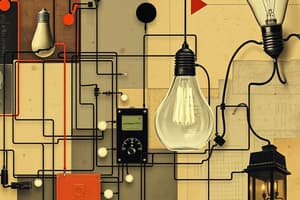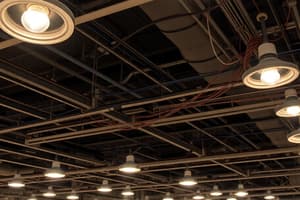Podcast
Questions and Answers
What is the primary function of insulation on electrical wires?
What is the primary function of insulation on electrical wires?
- To increase voltage
- To reduce the thickness of the wire
- To increase the current-carrying capacity
- To prevent electrical shock (correct)
Why is it important to clean fixtures regularly?
Why is it important to clean fixtures regularly?
- To change the mounting type of the fixture
- To prevent overheating and maintain efficiency (correct)
- To increase the lumen-per-watt value
- To reduce energy consumption
What type of mounting is suitable for fixtures installed in ceilings?
What type of mounting is suitable for fixtures installed in ceilings?
- Surface-mount
- Recessed-mount (correct)
- Suspended-mount
- Wet-location mount
What is the primary purpose of load calculations during installation?
What is the primary purpose of load calculations during installation?
What is measured by the lumen-per-watt value?
What is measured by the lumen-per-watt value?
What certification ensures that a fixture meets energy efficiency standards?
What certification ensures that a fixture meets energy efficiency standards?
What is the primary purpose of regular visual inspection during maintenance?
What is the primary purpose of regular visual inspection during maintenance?
What is the purpose of using fixtures rated for wet locations?
What is the purpose of using fixtures rated for wet locations?
What is the primary purpose of lamp replacement during maintenance?
What is the primary purpose of lamp replacement during maintenance?
What is the primary function of conductors in electrical wiring?
What is the primary function of conductors in electrical wiring?
Study Notes
Wiring
- Conductors: Copper or aluminum wires that carry electrical current to the fixture
- Insulation: Protective coating around the conductor to prevent electrical shock
- Voltage drop: Voltage loss due to wire resistance, affecting fixture performance
- Wire gauge: Thickness of the wire, affecting current-carrying capacity
Maintenance
- Lamp replacement: Regularly replace lamps to maintain optimal light output
- Dust and dirt removal: Clean fixtures to prevent overheating and maintain efficiency
- Visual inspection: Regularly inspect fixtures for signs of wear, corrosion, or damage
- Scheduled maintenance: Plan regular maintenance to prevent unexpected failures
Installation
- Mounting types: Surface-mount, recessed-mount, or suspended-mount fixtures
- Wiring connections: Secure and waterproof connections to prevent electrical shock
- Fixtures in wet locations: Use fixtures rated for wet locations, with waterproof connectors and gaskets
- Load calculations: Calculate total wattage and voltage requirements for the circuit
Energy Efficiency
- Lumen-per-watt (lm/W): Measure of energy efficiency, higher values indicate greater efficiency
- Energy Star certification: Meet energy efficiency standards set by the U.S. EPA
- LED lighting: Energy-efficient option with long lifespan and low energy consumption
- Dimming and occupancy sensors: Reduce energy consumption by adjusting light levels and turning off lights when not in use
Fixture Types
- Luminaires: General term for lighting fixtures, including lamps, fixtures, and lamps
- Task lighting: Direct lighting for specific tasks, such as reading or cooking
- Ambient lighting: Soft, general lighting for overall illumination
- Accent lighting: Focused lighting to highlight specific features or areas
Studying That Suits You
Use AI to generate personalized quizzes and flashcards to suit your learning preferences.
Description
Test your knowledge of the basics of lighting, including conductors, insulation, voltage drop, and wire gauge. Learn about maintenance tasks, installation methods, and energy-efficient options like LED lighting and dimming sensors. Explore different types of fixtures, including task, ambient, and accent lighting.




